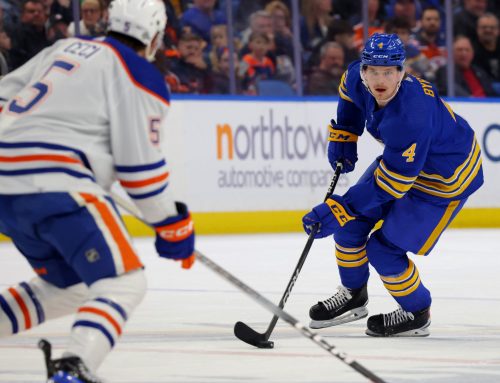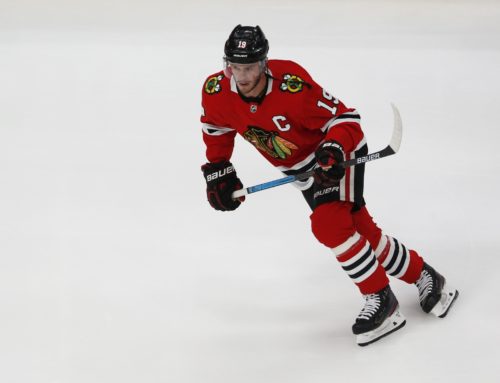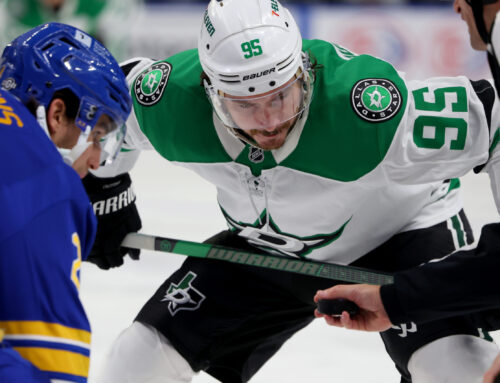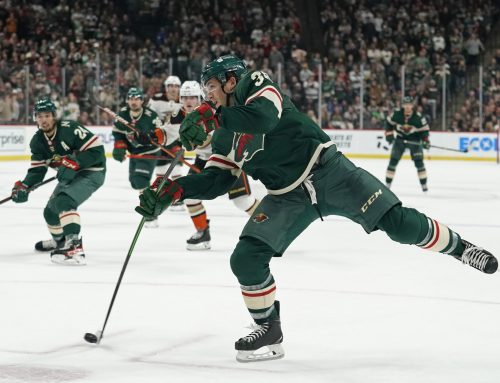
It’s Labour Day weekend which means, hopefully, you guys and gals have some time to just relax. It’s easier said than done for some, but now would be a great time to grab your copy of the 2018-19 Dobber Hockey fantasy guide from the Dobber Shop! It’ll be training camps before you know it so get a head start on your league mates and dig into the Dobber guide.
*
There was an informal skate for local Boston players yesterday and, naturally, most were Bruins players. Now, they weren’t all current Boston Bruins players, as, according to Amalie Benjamin, both Matt Beleskey and Colin Miller were on the ice. There was, however, another interesting name:
Lee Stempniak is also here.
— Amalie Benjamin (@AmalieBenjamin) August 30, 2018
Lee Stempniak is currently still a UFA.
This isn’t to say that the Bruins are on the verge of signing Stempniak or anything, but it is a signing, or potential PTO, that would make sense. It would be a one-year, low-dollar contract that can easily fit on this roster and provide a bit of punch on the third, likely fourth line.
Again, this is just for local players so maybe he’s just getting some ice time in with top competition and Boston isn’t interested at all. Just found it curious.
*
Not overly fantasy-relevant but Matt Stajan has signed in Germany so it seems his NHL career is effectively over.
Stajan was never really a prolific scorer, having cracked the 50-point mark twice and those two seasons, 2008-09 and 2009-10, being the only two years he managed at least 40. He also never scored 20 goals in a year. That being said, he was always a player who could be relied upon to be an effective third- or fourth-line centre, sometimes higher. He could contribute at both ends of the ice and, beyond that, was always seen as good in the community.
Best of luck to him with the new chapter of his career.
*
A little update from Max Pacioretty’s agent:
Max Pacioretty has stated repeatedly that he loves Montreal and wants to remain in Montreal. To this date, he’s never received any offer from Montreal. You can have 3 sources or 10 sources, how many times does Max have to state that he wants to remain in Montreal long term?
— Allan Walsh (@walsha) August 30, 2018
And then Playoff Larry chimed in:
As a friend, I hope Max Pacioretty’s situation is resolved soon. He has shouldered one of the toughest jobs in hockey wearing the C for the CH, taking responsibility and blame for things beyond his control. At the same time being one of the top goal scorers in the game.
— Lars Eller (@lellerofficial) August 30, 2018
He is as committed and cares as much as anyone I’ve ever played with. Any team would be lucky to have him.
— Lars Eller (@lellerofficial) August 30, 2018
*
Missed this last week but an interesting read from Travis Yost over at TSN on team discipline and home-ice penalties. Basically, he discusses penalty differential as a team talent and the effect of ‘getting the calls’ at each arena.
This applies to fantasy players whether in season-long leagues or daily. Hockey is a random game, especially when boiled down to a single day, so this isn’t to eschew certain teams on the road altogether. It does, however, show the importance of home calls to certain teams and the impact this can have in the fantasy realm. In a world where edges are getting smaller, things like this can make all the difference.
*
Yesterday’s ‘Capped’ from Alex MacLean, which was part 4 in his team-by-team series of players to buy and sell, made a point about one player in particular that changed my tune a little bit.
I have one salary cap league, it’s a keeper, and I had been thinking about putting in an offer to acquire Jeff Petry. Being that it’s a multi-category league, and he should be the PP QB for the first half of the year, I thought it made sense. Alex’s point, though, that now would be the time to sell on Petry rather than to buy on Petry isn’t one I really considered and it probably is the right move. Petry will hold a lot of value in multi-category leagues, but even for maybe a top-20 defenceman, $5.5-million is a lot in a cap league. If he can be sold for a profit at this point, that’s an avenue worth considering.
*
It’s officially the end of August. We’re under two weeks away from training camp. Once Labour Day is behind us, it’ll be full steam ahead for hockey preparation and drafts.
We talk a lot about player stats and value and comparisons and regression and on and on. We should spend a little bit of time on something that we don’t necessarily talk about very often and that’s how to approach and conduct a draft. A long way of saying draft strategy.
Some of this may be straightforward and repetitive, some of this may be new. Just bear with me as I explain how I approach a draft.
Always Check The Settings
Before getting into actual strategy, I cannot stress enough the importance of just checking the league settings. I know, I know, that should be obvious. Surely, I’m not the only one that has been caught off-guard by a unique league, though: whether a league counts hits and blocked shots or not; whether a league counts plus/minus or not; whether a league divides forwards by position or just counts them all as forwards; whether a league starts one goalie or two. All these things have varying degrees of impact on how we value players. Just never forget to take the 30 seconds to check settings. You don’t want to be caught drafting Nikita Zadorov in the 10th round of a points-only league.
Create Tiers
All too often, people show up at a draft with a list of 250 players and they just work their way down that list. Fantasy owners can probably get away with that in a points-only league. Fantasy owners probably cannot get away with that in almost any other format.
Here’s the problem with just drafting off a top-250 or top-300 list in a multi-category roto league: lists sort players by overall value and not necessarily by contribution in each category. In a multi-category league, it’s vital to cover as many bases as possible when drafting. Guys who contribute in just three or four out of seven or eight categories are fine, but there are diminishing returns. Once your team leads the league in goals, you don’t get extra points for leading by even more goals. You need to roster players who can contribute everywhere. This is where tiering helps.
Fantasy owners should create a tier of across-the-board contributors, point-production guys, peripheral stat-stuffers, and sort them from most to least valuable in those tiers. It helps to figure out which type of players are left and what is missing from a given roster. It takes 20 minutes and saves a lot of in-season headaches.
Solidify Your Core
The way you start a draft is up to the individual player. Whether subscribing to Laidlaw’s theory of grabbing elite defencemen early, grabbing elite goalies early, or any other approach, I believe the most important thing to remember about the early goings-on of a draft is to just solidify your core.
What exactly constitutes a ‘core’ can differ for different fantasy owners, but I generally refer to my first eight picks in a 12-team league as my core. That takes us nearly to pick 100.
The meaning behind ‘solidify your core’ is to not take unnecessary risks. Fantasy drafts aren’t necessarily won in the first third – the 31st overall pick finishing as the 23rd overall player is nice but won’t win a draft – but they sure can be lost – the 31st overall pick finishing as the 174th overall player will hurt a lot. If the player gets injured, that’s one thing. But if the player is coming off a career year without a track record and a very high pick is being spent on this being repeated, well, sometimes in life you get what you deserve.
Through the early portion of a draft, I just don’t want to lose significant value. If each of my first eight picks, whether it’s a 5-2-1 split or 4-3-1 or 3-3-2 or whatever, can finish relatively close to their draft slot, it’s a very good start. Once my core is set, that’s when we get to the next recommendation below.
Shoot Your Shot
Once that core is solidified, don’t be afraid to shoot your shot. In other words, don’t be afraid to go get the guy you want.
There’s a caveat here: don’t go crazy. If there is a player whose ADP is 198 and is generally ranked outside the top-175 from fantasy sources around the industry (like our Dobber guide!), there’s no need to grab him in the 10th round. But once the 12th, 13th, or 14th rounds come around? Go ahead and grab him. Maybe you think he’s undervalued. Maybe you think he’ll work his way up a lineup or onto a top PP unit. Maybe you think a goalie is due for a bounce back or his ADP isn’t taking his team or talent into account. There could be any number of reasons why you think he’s being undervalued. Regardless, don’t be afraid to shoot your shot and get your guy a couple rounds early. Once you get to the latter part of a draft, missing on a 16th-round pick isn’t really a big deal. The waiver wire replacement value is low.
Just don’t make a habit of reaching for half your roster a few rounds early.
Look For Arbitrage Opportunities All Draft Long
Arbitrage may be something unfamiliar to even long-time fantasy players. It’s something I’ve written about on this site in previous seasons as well as something that was covered recently by Cam Metz in one of his Eastern Edge columns. To put it simply, it’s identifying a player who can provide a similar value in similar categories to another player who is being drafted much higher. Basically, why waste a 7th round pick on a player if you think a similar option can be had in the 12th round?
This was something I alluded to in a Ramblings back in June on name value and actual production. Whether it be name value, excitement for a young player, excitement for a team, or any other number of reasons, players are over and undervalued all the time. Being able to assess each player on their own expected production and ranking accordingly can help identify these arbitrage opportunities. There are some players I’ll touch on the coming weeks to help fantasy owners.





 SEA
SEA NYI
NYI BUF
BUF DAL
DAL
 CBJ
CBJ STL
STL L.A
L.A NYR
NYR ANA
ANA DET
DET
